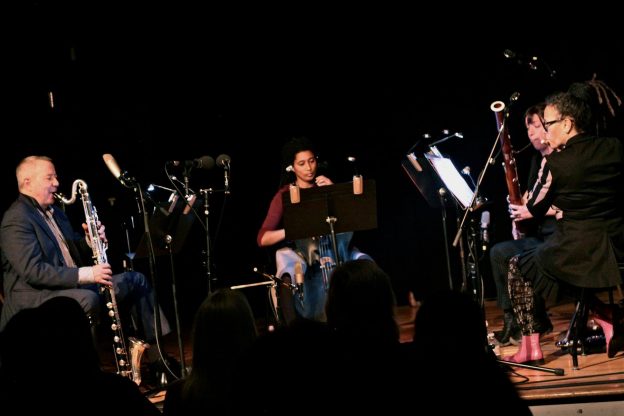by Glenn Siegel
A great bubbling up. That’s the feeling I had as tenor saxophonist James Brandon Lewis and drummer Chad Taylor shared their music on Friday, December 14 at a concert produced by Pioneer Valley Jazz Shares at the 121 Club in Easthampton. Lewis and Taylor have absorbed the lessons and shared traditions of this music, and are at a point in their art where ideas and spirit seem to flow without restraint.
I’ve heard Lewis play twice at the Vision Festival in New York, once with his trio and last year in the company of Dave Burrell, Kidd Jordan, William Parker, and Andrew Cyrille. I was super impressed both times. But it was a treat to spend time with him and hear his music in such an intimate setting. The 35-year old, Buffalo, NY native is self-directed and very serious about his music. Although he was in the Valley for less than 24 hours, he brought two large books by Walter Piston, “Harmony” and “Counterpoint”, with him. Over dinner, he told us about feeling inspired and validated after spending time with the Sonny Rollins archive at the Schomburg Center for Research in Black Culture in Harlem. Seeing Rollins’ own thoughtful writings concerning fingerings, breath, exercises, and other details of his craft, confirmed for Lewis that gifts from God only bloom when coupled with the dogged pursuit of knowledge.
Although he attended Howard and holds an MFA from CalArts, Lewis strikes me as someone who has figured out a lot of stuff on his own. I kind of like that he doesn’t double on any other horn. His playing was strong, confident, and filled with emotion. There was something old-school about his sound, even as he explored the tenor’s outer reaches. He was equally compelling whether he was whispering or wailing, a sure sign of command.
This was Lewis’ first trip to western Massachusetts. Chad Taylor was making his third appearance in the Valley in two months. He played with Jason Stein and Paul Giallorenzo as Hearts & Minds (Oct. 13, Shea Theater,) and was one-fourth of Darius Jones’ Shades of Black (October 25, UMass.) His previous trips to the area include encounters with Fred Anderson and Rob Mazurek (Chicago Underground Duo.)
In an era of drum master bounty, Taylor is royalty. Throughout the evening, he moved the music by shifting time and mood, but he also served as accompanist, creating structure, songs in effect, for the saxophone to solo over. His unaccompanied solo mid-way through the 80-minute set, grew to a ferocious, Blakey-like avalanche; within seconds of Lewis’ re-entry, however, they ended on a sweet, fading note. The two pieces featuring Taylor’s mbira, or thumb piano, gave the duo a chance to access ancestors and luxuriate in deep vibration. The bass note of the instrument resonated with me in a literal sense.
The spirit of John Coltrane was felt all evening. Strains of “Impressions” and “Lonnie’s Lament” were heard. Thoughts of Trane’s duets with drummer Rashied Ali circulated. “In and out of jazz, Coltrane tributes are legion;” writes Hank Shteamer in Rolling Stone about Lewis and Taylor’s duo recording, Radiant Imprints, “this was the rare one that put forward a highly developed, refreshingly personal perspective in place of run-of-the-mill reverence.”
The recording has been listed among the Top 20 Jazz Records of 2018 in Rolling Stone, the New York Times, and elsewhere, confirming what we know from first hand experience: James Brandon Lewis and Chad Taylor are forces to reckon with.
Lewis and Taylor. They could be explorers. Yes, they’re explorers.

